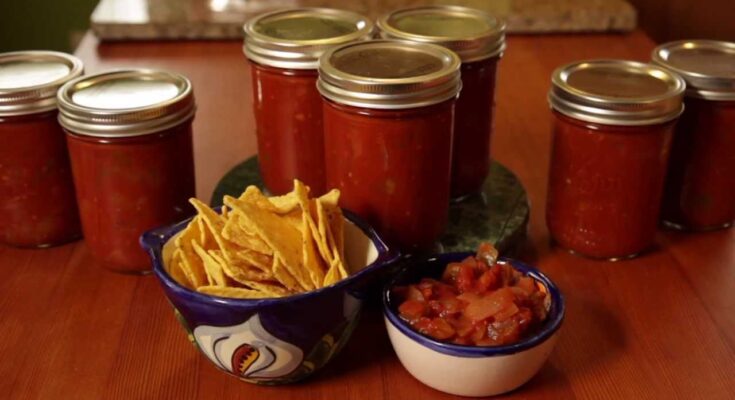Canned Salsa Recipe: There’s nothing quite like popping open a jar of homemade canned salsa and enjoying the flavor of fresh vegetables, spices, and love that went into it. Making your own salsa at home isn’t just satisfying—it’s downright smart. Not only do you control every single ingredient that goes into the jar, but you also avoid preservatives, artificial flavoring, and unnecessary sugars that store-bought brands often sneak in.
Canning your own salsa allows for full customization. Want more heat? Toss in extra jalapeños. Prefer it chunky with big tomato bits? You got it. Making salsa at home gives you the power to tweak it until it’s perfect for your taste buds. It’s not just about saving money either—it’s about creating a pantry full of wholesome, homemade goodness.
Let’s not forget the sense of pride. Sharing your canned salsa with friends and family at gatherings, or even gifting a jar, often leads to compliments and recipe requests. And once you’ve done it once, it gets easier every season.
What Makes Canned Salsa So Popular?
Canned salsa isn’t just popular because it’s delicious—it’s popular because it’s practical. It’s one of the most versatile condiments out there. You can use it as a dip, a topping, or a cooking ingredient. Got tacos? Add salsa. Cooking chicken? Simmer it in salsa. Need a quick snack? Chips and salsa have your back.
Also, canned salsa has an impressively long shelf life—up to 18 months if stored properly. That means you can stock up when produce is in season and enjoy the flavors year-round. It’s a hit for meal preppers, foodies, and gardeners alike.
Essential Ingredients for Canned Salsa
Fresh Produce Selection
The foundation of a great canned salsa recipe lies in the quality of your produce. Here’s what you’ll need, and why each matters:
- Tomatoes: Use paste tomatoes like Roma or San Marzano. These have fewer seeds and more flesh, making your salsa thick rather than watery.
- Onions: Yellow or white onions add the perfect sharp bite and body to your salsa. They also help build that rich base flavor.
- Peppers: This includes bell peppers for sweetness and jalapeños for heat. Want more fire? Add serranos or habaneros.
- Garlic: A non-negotiable. Fresh minced garlic adds depth and that classic Mexican zing.
- Cilantro: Some love it, some hate it, but it brings a fresh, herby brightness to salsa.
- Lime Juice or Vinegar: You need acid to make your salsa safe for canning. It also balances the flavors.
Always go for fresh, firm produce with no bruising. Organic is ideal, especially if you’re planning on peeling the tomatoes and not removing skins.
Pantry Staples and Add-ins
To round out your salsa, you’ll need a few pantry staples:
- Salt: Acts as a preservative and brings all the flavors together.
- Sugar (Optional): Just a pinch can balance out the acidity of the tomatoes and vinegar.
- Cumin or Coriander: A hint of earthy spice for that authentic Southwestern touch.
- Black Pepper: Adds a gentle kick without overpowering.
Some people also add corn or black beans to their canned salsa, though these can affect the acidity and safety of the canning process. If you want to include them, follow pressure canning methods instead.
Tools and Equipment Needed for Canning
Must-Have Canning Gear
Before you dive in, gather your gear. Here’s the basic lineup:
- Water Bath Canner: For high-acid foods like salsa, this is the safest and simplest method.
- Canning Jars (Pint or Half-Pint): Make sure they’re free from cracks and have matching lids and rings.
- Jar Lifter: You don’t want to burn your hands lifting hot jars!
- Funnel: Helps you pour the salsa cleanly into jars without mess.
- Lid Wand: A magnetized stick that makes handling hot lids a breeze.
- Bubble Remover Tool: Gets air bubbles out before sealing the jars.
Optional Tools That Make Life Easier
These tools aren’t essential but they definitely help:
- Food Processor: Speeds up chopping veggies.
- Tomato Peeler/Corer: Makes prepping large batches of tomatoes easier.
- Cooking Thermometer: Ensures your salsa stays at the right temperature while cooking.
Having everything laid out before you start can save time and stress. Trust me, nothing’s worse than realizing you’re missing a tool mid-salsa session.
Preparing the Ingredients for Your Salsa
Washing and Chopping the Vegetables
The prep stage is just as important as the cooking. First things first: wash all your produce thoroughly. Even if it’s organic, there could be dirt, bugs, or pesticide residue.
Next, start chopping. The size of your chop affects the final texture. For a chunky salsa, dice everything into small cubes. For a smoother salsa, go smaller or use a food processor to pulse the ingredients.
Here’s a pro tip: peel your tomatoes by blanching them in boiling water for 30 seconds, then dunking them in ice water. The skins will slip right off, leaving you with smoother, seedless tomato flesh perfect for canning.
Balancing Acidity and Flavor
This is a crucial step. Canning salsa isn’t just about taste—it’s also about safety. Tomatoes vary in acidity, and adding low-acid ingredients like onions and peppers can throw off the pH balance.
To fix that, always add bottled lemon juice or vinegar to your salsa. Use:
- 2 tablespoons of bottled lemon juice per pint jar, or
- 1/4 cup of vinegar per batch (about 6-7 pint jars).
Don’t skip this. Without enough acidity, your salsa can spoil on the shelf. You’re not just cooking—you’re preserving!
Cooking the Salsa for Canning
The Ideal Salsa Texture
Now that everything’s chopped and balanced, it’s time to get cooking. Combine all your ingredients in a large pot and bring it to a simmer over medium-high heat. Stir occasionally to prevent sticking and burning.
Let the salsa cook for about 30 to 45 minutes. This allows flavors to meld and moisture to evaporate. If your salsa looks watery, keep cooking until it thickens up. You want a nice spoonable consistency—not too runny, not too chunky.
If you’re going for restaurant-style salsa, use an immersion blender for a few pulses to smooth things out without turning it into puree.
Adjusting Seasoning While Cooking
Taste as you go. This is where the magic happens. Add salt, pepper, more vinegar, or extra chilies based on your preference. Remember, flavors intensify as the salsa sits, so don’t go too heavy-handed.
Once the salsa reaches the flavor and texture you love, it’s ready for jarring.
Sterilizing and Prepping the Jars
Why Sterilization Matters
When it comes to canning, cleanliness isn’t just important—it’s critical. Sterilizing your jars helps prevent bacteria, mold, or yeast from ruining your salsa. Even the tiniest speck of contamination can spoil an entire jar, making your efforts go to waste or even leading to foodborne illness.
Start by washing your jars, lids, and rings with hot soapy water. Then rinse thoroughly. To sterilize the jars, place them in a large pot of boiling water for at least 10 minutes. You can also place them in a preheated oven at 225°F (about 107°C) for 20 minutes.
Keep the jars warm until you’re ready to use them. This prevents cracking when hot salsa is poured in. Remember, do not boil the lids—just warm them in hot water. Boiling can damage the sealing compound.
Setting Up Your Workstation
Have your salsa, sterilized jars, funnel, ladle, and jar lifter ready. Lay out a clean towel on your counter to place filled jars before they go into the water bath. The more organized your space, the smoother the canning process will go.
Filling the Jars with Salsa
How to Properly Fill the Jars
Here’s where all that prep pays off. Using a funnel, ladle the hot salsa into your sterilized jars. Leave about 1/2 inch of headspace at the top. This space allows for expansion during processing and helps create a proper vacuum seal.
Use a bubble remover or a non-metallic utensil (like a chopstick) to slide down the sides of the jar, releasing any trapped air bubbles. Wipe the jar rims clean with a damp cloth—any residue could interfere with sealing.
Place the lid on each jar and screw on the ring until it’s fingertip tight. Don’t over-tighten—air needs to escape during the water bath.
Common Filling Mistakes to Avoid
- Overfilling: This can cause salsa to leak out during processing, preventing a good seal.
- Underfilling: Too much headspace can result in air remaining in the jar, reducing shelf life.
- Not removing air bubbles: This leaves air pockets that could harbor bacteria.
Taking your time with this step ensures your salsa stays safe and fresh on the shelf.
Water Bath Canning Process
How to Process Your Salsa
Place your filled jars into the water bath canner using a jar lifter. Make sure the water covers the tops of the jars by at least 1 to 2 inches. Cover the pot and bring to a rolling boil.
Once boiling, process pint jars for 15 to 20 minutes depending on your altitude (you may need more time at higher elevations). This heat process kills harmful microorganisms and helps the lid create an airtight seal.
When time is up, turn off the heat and let the jars sit in the hot water for about 5 minutes. This allows pressure inside the jars to equalize, reducing the risk of cracking when removed.
How to Tell When They’re Done
Use the jar lifter to carefully remove jars and place them on a towel-lined surface. Leave at least 1 inch between jars to allow airflow. Let them cool undisturbed for 12 to 24 hours.
Listen for the sweet “pop” sound of jars sealing as they cool. It’s the sound of success! Once fully cooled, check the seals by pressing the center of each lid. If it doesn’t flex, it’s sealed. If it pops back up, refrigerate and use that jar first.
Storing Your Canned Salsa
How to Store Salsa Safely
Once sealed and labeled, store your jars in a cool, dark place like a pantry or basement. Properly canned salsa will last 12 to 18 months. Keep them away from direct sunlight or temperature fluctuations, which can break down the quality of the food.
Be sure to label each jar with the date you canned it. That way, you can use older jars first and avoid waste.
Signs Your Salsa Has Gone Bad
Even with the best practices, sometimes a jar might not seal or go bad over time. Always check before eating:
- Bulging lids
- Leaking contents
- Mold inside the jar
- Sour or “off” smell when opened
When in doubt, throw it out. Better safe than sorry.
Serving Ideas and Salsa Variations
Creative Ways to Use Your Canned Salsa
Salsa isn’t just a dip—it’s a kitchen MVP. Here are some tasty ways to enjoy it:
- Taco Topping: Obvious, but unbeatable.
- Egg Scramble Boost: Stir into your morning eggs for instant flavor.
- Salsa Chicken: Dump a jar over chicken breasts and bake.
- Salsa Rice: Mix into cooked rice for a quick, zesty side dish.
- Soup Starter: Use it as a base for tortilla soup or chili.
The possibilities are endless. One jar of salsa can transform a basic meal into something bold and exciting.
Salsa Flavor Variations to Try
Want to switch things up? Try these fun tweaks:
- Roasted Salsa: Char tomatoes, onions, and peppers before cooking.
- Fruit Salsa: Add diced mango or pineapple for a sweet twist.
- Fire-Roasted Corn Salsa: Add charred corn kernels for texture and flavor.
- Smoky Chipotle Salsa: Add chipotle peppers in adobo for a deep, smoky kick.
Just remember: if you change the ingredients too much (especially the acidity), you may need to use pressure canning instead of a water bath to keep it safe.
Troubleshooting Common Canning Issues
Why Didn’t My Jars Seal?
One of the most frustrating things about canning is finding out a jar didn’t seal properly after all your hard work. But don’t worry—it’s not a total loss. First, let’s look at the usual culprits:
- Lid not centered: If the lid wasn’t placed properly, it might not form a vacuum seal.
- Dirty rim: Any salsa residue on the jar rim can prevent a good seal.
- Not enough headspace: Overfilling your jars can lead to leakage during the water bath.
- Old or damaged lids: Always use new lids and check for warps or defects.
If a jar doesn’t seal within 24 hours, you have two options: refrigerate and eat it within a week, or reprocess it with a new lid within 24 hours.
What to Do If Salsa Spoils
Even if you followed the steps, spoilage can still occur occasionally. If you notice mold, bubbling, foul odor, or a lid that’s bulging or leaking, toss the contents right away. Never taste it to check—it’s not worth the risk.
Prevention is key. Always follow tested canning recipes, maintain cleanliness, and don’t skip the acid!
Nutritional Information and Health Benefits
Health Perks of Homemade Salsa
Homemade canned salsa isn’t just tasty—it’s actually pretty healthy. It’s packed with vegetables, which means lots of fiber, vitamins, and antioxidants. Tomatoes bring lycopene, which supports heart health. Peppers boost metabolism and garlic can help with immunity.
Compared to store-bought versions, homemade salsa usually has:
- Less sodium
- No preservatives
- No added sugars
- No artificial ingredients
It’s basically flavor-packed goodness in a jar that fits into almost any diet.
Calories and Serving Size
On average, a 1/4-cup serving of homemade salsa contains:
- 15–25 calories
- 0g fat
- 1g protein
- 4g carbs
- 0g added sugar
It’s naturally low-calorie and can easily be incorporated into low-carb, keto, vegan, and gluten-free diets.
Canning Salsa for Gifting and Sharing
Creative Gift Ideas with Salsa Jars
If you’re into DIY gifts, canned salsa is an absolute winner. It’s heartfelt, delicious, and practical—all in one jar. Here are some creative ways to present your salsa gifts:
- Decorative labels: Add handwritten or printed labels with the name of the salsa, date, and heat level.
- Fabric covers: Place a square of fabric over the lid and secure with twine or a ribbon for a rustic touch.
- Gift baskets: Pair with tortilla chips, a bottle of hot sauce, or homemade queso.
Your friends and family will appreciate the thought (and the flavor).
Best Occasions to Share Your Homemade Salsa
- Holiday gifts
- Housewarming presents
- Potlucks or BBQs
- Hostess gifts
- Teacher appreciation
It’s a way to share your kitchen creativity and give a unique gift that people will actually use—and love.
Sustainability and Using Garden Produce
Reduce Waste by Canning Your Harvest
If you’re a home gardener, you know how quickly tomatoes, peppers, and herbs can pile up. Instead of letting produce go bad, canning salsa is a great way to preserve that hard work and reduce food waste.
No need to throw away overripe or “ugly” veggies—they’re perfect for salsa. As long as they’re not spoiled, their appearance doesn’t matter once they’re chopped and cooked.
Eco-Friendly Canning Practices
- Use reusable jars and rings
- Compost scraps from veggie prep
- Avoid plastic packaging by skipping store-bought salsa
- Source your produce locally or grow it yourself
Homemade salsa isn’t just better for your body—it’s better for the planet, too.
Scaling Up Your Canned Salsa Production
Batch Cooking for Big Salsa Projects
Got a bumper crop? Or planning for a big event? You can easily scale this recipe up to make double or triple batches. Just be sure to:
- Use a large enough pot to avoid overflow
- Maintain the right acidity-to-ingredient ratio
- Stir frequently to prevent scorching
Larger batches save time and energy, especially if you’re trying to stock up your pantry or prepare gifts for the whole family.
Selling Your Homemade Salsa
Thinking about turning your salsa hobby into a side hustle? Many local markets and small shops welcome homemade, artisanal goods.
But there’s a catch—you’ll need to follow local cottage food laws or health department guidelines for selling canned goods. These often include:
- Approved kitchen inspections
- Food handler certification
- Specific labeling requirements
Do your homework, and you could turn your love of salsa into a legit business.
Final Tips for Perfect Canned Salsa Every Time
Top Secrets from Experienced Canners
Want to level up your salsa canning game? Here are some golden rules seasoned home canners swear by:
- Use bottled lemon juice, not fresh – This ensures consistent acidity, which is essential for safe canning.
- Don’t skip salt – It’s not just for flavor; it helps preserve and maintain texture.
- Avoid thickening agents like cornstarch – They affect heat distribution and can make your salsa unsafe.
- Use the freshest ingredients – The quality of your final salsa is only as good as what goes into it.
- Keep a detailed log – Note what ingredients and techniques you used each time, especially when you experiment. That way, it’s easier to replicate perfection—or avoid past mistakes.
Best Time of Year to Can Salsa
Late summer is salsa season! Tomatoes, peppers, and herbs are at their peak. However, if you freeze fresh produce, you can make and can salsa year-round. Still, nothing beats the flavor of freshly harvested garden veggies.
FAQs About Canned Salsa Recipe
Q1: Can I use fresh tomatoes instead of canned for this salsa?
Yes, absolutely! Fresh tomatoes give a vibrant flavor. Just be sure to peel and core them before use.
Q2: How long does canned salsa last?
If processed properly and stored in a cool, dark place, canned salsa can last up to 12–18 months. Once opened, keep it in the fridge and use within a week.
Q3: Can I reduce the vinegar or lemon juice?
Nope! The acidity is crucial for safe canning. Reducing it can mess with the pH and invite unwanted bacteria. Stick to the recipe.
Q4: Can I add mangoes or pineapples for sweetness?
You can for fresh salsa, but for canning—avoid low-acid fruits unless you’re using a tested recipe. They affect safety.
Q5: Why is my canned salsa watery?
Tomatoes release a lot of juice when cooked. For a thicker salsa, you can drain some of the tomato juice before cooking or simmer longer to reduce.
Q6: Can I use a blender instead of chopping everything?
Yes, but don’t overdo it! Pulse the ingredients if you like a smoother salsa—but too much blending can turn it into soup.
Q7: Do I need a pressure canner?
Nope, not for salsa with enough acidity. A boiling water bath method is safe, as long as the recipe has the right vinegar or lemon juice content.
Q8: Can I make it spicier?
Totally! Add more jalapeños, serranos, or even habaneros—just don’t mess with the vinegar or tomato-to-pepper ratio for safe canning.
Conclusion
This guide walked you through everything you need to know—from ingredients and prep to cooking, canning, and storing. Whether you’re making a small batch for your family or cooking up a dozen jars for gifts, canned salsa brings unbeatable flavor and satisfaction.
Now that you’ve mastered the basics, don’t be afraid to experiment, get creative with flavors, and most importantly—have fun. Your pantry (and your taste buds) will thank you.



